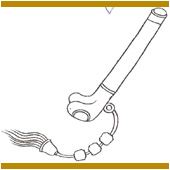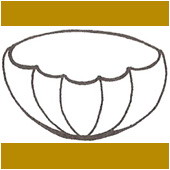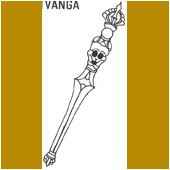
K
Kali
In Vedic times, this name meant "the black" and was associated with Agni, the
god of fire, who had seven tongues with which to lick the offerings of butter.
Of these seven, Kali was the black terrifying manifestation of Devi, the consort
of Shiva. She has a hideous, tusked face, which is smeared with blood, and four
arms, one of which holds a weapon and another, the head of a giant dripping
with blood. Her other two arms are raised to bless worshipers. Her ornaments
include snakes, skulls, and figures of children.
Kangling
This ritual trumpet made of human thighbone. When blown it serves to drive away evil spirits. Tibetan lamas used it.

Kapala, kapalapatra
This is a bowl made of human skull. In Tantra it is used as a bowl containing either meat or blood, which is offered as a sacrifice to propitiate protective deities

Karma
The law of cause and effect. One's present life is the result of past actions,
either in this life or in former lives. Karma ceases when one attains nirvana,
and the cycle of births and deaths is broken. Karma is closely linked with samsara,
or transmigration.
Khatvanga
This staff is not an ordinary one. It is ornately decorated with a skull and a vajra on top of it. It is regarded as possessing magical powers, and hence, is the symbol of supernatural power – siddhi.

Khmer
The ancient and modern inhabitants of Cambodia. From the 7th to the
14th centuries C.E., the Khmer established a powerful kingdom based
at Angkor from which they ruled over much of Indochina.
Khon
A form of classical Thai Theater, performed by masked dancers with a chorus
and orchestra. The themes are taken from the Ramakien, the Thai version of the
Indian epic poem. The Ramayana.
Kinnara
Originally a mythical is being who had a human body and the head of a horse,
or vice versa. In later times it became a combination of a bird and a man or
woman, with a human chest and head, and the wings and feet of a bird. In India,
the kinnaras were a subgroup of heavenly musicians, or gandharvas.
Kinnari
The female form of kinnara.
Kirtimukha
The "face of glory" is usually represented as a face with two horns, round bulbous
eyes, a human or lion's nose, a wide mouth with teeth, with or without a lower
jaw. This term is sued in India for the mask-like creature appearing above temple
doorways. It is intended to drive away evil and protect the devout, in both
Hindu and Buddhist mythology. The same creature is called kala in Cambodia,
Indonesia, and Thailand.
Kranok
A flame-like design commonly used in Thailand.
Kris
A short sword with a straight or curved blade, forged from iron ore and meteorite.
It occupies an important place in Indonesian and Malaysian warfare. The handle
of a ceremonial kris is highly decorated.
Kwan Yin
The bodhisattva of compassion in Mahayana Buddhism in China often represented
as a female. See Avalokitesvara.